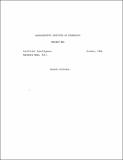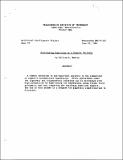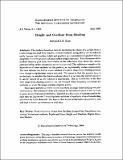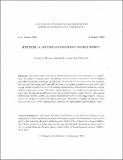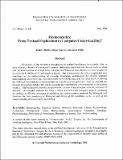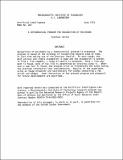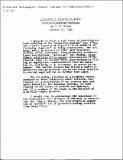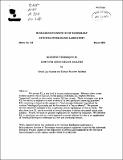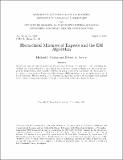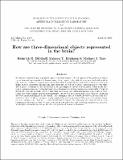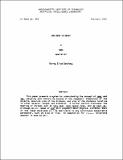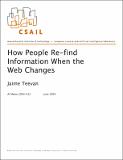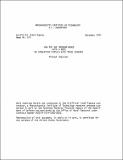Browsing AI Memos (1959 - 2004) by Title
Now showing items 438-457 of 1217
-
HAKMEM
(1972-02-01)Here is some little know data which may be of i nterest to computer hackers. The items and examples are so sketchy that to decipher them may require more sincerity and curiosity than a non-hacker can muster. Doubtless, ... -
Hardware and Program Memo About SERVO
(1967-03-01)SERVO is intended as an engineering and programming analyzing and debugging aid for use with devices connected through the input and output multiplexers to the PDP-6. Cannel numbers and values to output, as well as ... -
Hardware Memo - Input Multiplexer Status
(1966-10-01)Note: Computer control of Input Multiplexer and Output Sample and Hold is available when clock and test switches on the I/O box are in "Computer Input" and "Computer Output" positions, respectively. Manual operation of the ... -
Hash-Coding Functions of a Complex Variable
(1964-06-25)A common operation in non-numerical analysis is the comparison of symbolic mathematical expressions. Often equivalence under the algebraic and trigonometric relations can be determined with the high probability by hash-coding ... -
Height and Gradient from Shading
(1989-05-01)The method described here for recovering the shape of a surface from a shaded image can deal with complex, wrinkled surfaces. Integrability can be enforced easily because both surface height and gradient are represented. ... -
Herbert: A Second Generation Mobile Robot
(1988-01-01)In mobile robot research we believe the structure of the platform, its capabilities, the choice of sensors, their capabilities, and the choice of processors, both onboard and offboard, greatly constrains the direction of ... -
Hermeneutics: From Textual Explication to Computer Understanding?
(1986-05-01)Hermeneutics, a branch of continental European philosophy concerned with human understanding and the interpretation of written texts, offers insights that may contribute to the understanding of meaning, translation, ... -
A Heterarchical Program for Recognition of Polyhedra
(1972-06-01)Recognition of polyhedra by a heterarchical program is presented. The program is based on the strategy of recognizing objects step by step, at each time making use of the previous results. At each stage, the most obvious ... -
A Heuristic Program that Constructs Decision Trees
(1969-03-01)Suppose there is a set of objects, {A, B,...E} and a set of tests, {T1, T2,...TN). When a test is applied to an object, the result is wither T or F. Assume the test may vary in cost and the object may vary in probability ... -
A Heuristic Program to Solve Geometric Analogy Problems
(1962-10-01)A program to solve a wide class of intelligence-test problems of the "geometric-analogy" type ("figure A is to figure B as figure C is to which of the following figures?") is being constructed. The program, which is written ... -
Heuristic Techniques in Computer Aided Circuit Analysis
(1975-03-01)We present EL, a new kind of circuit analysis program. Whereas other circuit analysis systems rely on classical, formal analysis techniques, EL employs heuristic "inspection" methods to solve rather complex DC bias ... -
Hidden Clues in Random Line Stereograms
(1983-08-01)Successful fusion of random-line stereograms with breaks in the vernier acuity range has been previously interpreted to suggest that the interpolation process underlying hyperacuity is parallel and preliminary to ... -
Hierarchical Mixtures of Experts and the EM Algorithm
(1993-08-01)We present a tree-structured architecture for supervised learning. The statistical model underlying the architecture is a hierarchical mixture model in which both the mixture coefficients and the mixture components are ... -
Holes
(1968-08-01)This memo originally had two parts. The first dealt with certain deficiencies in an early version of Guzman's program, SEE. The problems have been fixed, and the corresponding discussion has been dropped from this ... -
How are Three-Deminsional Objects Represented in the Brain?
(1994-04-01)We discuss a variety of object recognition experiments in which human subjects were presented with realistically rendered images of computer-generated three-dimensional objects, with tight control over stimulus shape, ... -
How do Humans Determine Reflectance Properties under Unknown Illumination?
(2001-10-21)Under normal viewing conditions, humans find it easy to distinguish between objects made out of different materials such as plastic, metal, or paper. Untextured materials such as these have different surface reflectance ... -
How Near is Near?
(1976-02-01)This paper presents a system for understanding the concept of near and far, weighing such factors as purpose of the judgement, dimensions of the objects, absolute size of the distance, and size of the distance relative ... -
How People Re-find Information When the Web Changes
(2004-06-18)This paper investigates how people return to information in a dynamic information environment. For example, a person might want to return to Web content via a link encountered earlier on a Web page, only to learn that the ... -
How the GAS Program Works with a Note on Simulating Turtles with Touch Sensors
(1972-12-01)The GAS program is a display simulation of a 2 dimensional ideal gas. Barriers, or walls, are line segments, and molecules, alias particles or balls, are circles. Collisions occur between balls and other balls as well ... -
How to Do the Right Thing
(1989-10-01)This paper presents a novel approach to the problem of action selection for an autonomous agent. An agent is viewed as a collection of competence modules. Action selection is modeled as an emergent property of an ...


